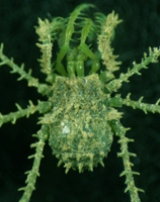
Laniatores
Encyclopedia
Laniatores is the largest suborder of the arachnid
order Opiliones
with over 4,000 described species worldwide. The majority of the species are highly dependent on humid environments and usually correlated with tropical and temperate forest habitats.
Laniatores are typically (relatively) short-legged, hard-plated, spiny Opiliones, common under logs and stones, in leaf litter and in cave
s. They often have spiny pedipalp
s and paired or branched claws on the third and fourth pairs of legs.
The largest family is Gonyleptidae
Sundevall, 1833, endemic of the Neotropics, with over 800 valid species and showing many cases of maternal and paternal care.
or peltidium
entirely fused with abdominal scutum. Pedipalpus usually robust and armed with strong spines. Ovipositor
short, unsegmented (derived character state shared with the Dyspnoi). Penis complex, with many sclerite
s, some movable, a single penial muscle present, but mostly penis without any muscles, working by hemolymph
pressure.
Definitions and limits of superfamilies are still in a state of flux. The largest by far is the Gonyleptoidea, with almost 2,500 described species.
Arachnid
Arachnids are a class of joint-legged invertebrate animals in the subphylum Chelicerata. All arachnids have eight legs, although in some species the front pair may convert to a sensory function. The term is derived from the Greek words , meaning "spider".Almost all extant arachnids are terrestrial...
order Opiliones
Opiliones
Opiliones are an order of arachnids commonly known as harvestmen. , over 6,400 species of harvestmen have been discovered worldwide, although the real number of extant species may exceed 10,000. The order Opiliones can be divided into four suborders: Cyphophthalmi, Eupnoi, Dyspnoi and Laniatores...
with over 4,000 described species worldwide. The majority of the species are highly dependent on humid environments and usually correlated with tropical and temperate forest habitats.
Laniatores are typically (relatively) short-legged, hard-plated, spiny Opiliones, common under logs and stones, in leaf litter and in cave
Cave
A cave or cavern is a natural underground space large enough for a human to enter. The term applies to natural cavities some part of which is in total darkness. The word cave also includes smaller spaces like rock shelters, sea caves, and grottos.Speleology is the science of exploration and study...
s. They often have spiny pedipalp
Pedipalp
Pedipalps , are the second pair of appendages of the prosoma in the subphylum Chelicerata. They are traditionally thought to be homologous with mandibles in Crustacea and insects, although more recent studies Pedipalps (commonly shortened to palps or palpi), are the second pair of appendages of the...
s and paired or branched claws on the third and fourth pairs of legs.
The largest family is Gonyleptidae
Gonyleptidae
Gonyleptidae is a Neotropical family of harvestmen with more than 800 species, the largest in the Suborder Laniatores and the second largest of the Opiiones as a whole...
Sundevall, 1833, endemic of the Neotropics, with over 800 valid species and showing many cases of maternal and paternal care.
Identification
Dorsal scutum consisting in a single piece, carapaceCarapace
A carapace is a dorsal section of the exoskeleton or shell in a number of animal groups, including arthropods such as crustaceans and arachnids, as well as vertebrates such as turtles and tortoises. In turtles and tortoises, the underside is called the plastron.-Crustaceans:In crustaceans, the...
or peltidium
Peltidium
Peltidium is a prodorsal shield found in animals of the Subphylum Chelicerata, in the Phylum Arthropoda. In some groups the peltidium, also known as schizopeltid, can be subdivided in: propeltidium, a capace-like shield that covers the proterosoma, which comprises the fused acron and first four...
entirely fused with abdominal scutum. Pedipalpus usually robust and armed with strong spines. Ovipositor
Ovipositor
The ovipositor is an organ used by some animals for oviposition, i.e., the laying of eggs. It consists of a maximum of three pairs of appendages formed to transmit the egg, to prepare a place for it, and to place it properly...
short, unsegmented (derived character state shared with the Dyspnoi). Penis complex, with many sclerite
Sclerite
A sclerite is a hardened body part. The term is used in various branches of biology for various structures including hardened portions of sponges, but it is most commonly used for the hardened portions of arthropod exoskeletons....
s, some movable, a single penial muscle present, but mostly penis without any muscles, working by hemolymph
Hemolymph
Hemolymph, or haemolymph, is a fluid in the circulatory system of some arthropods and is analogous to the fluids and cells making up both blood and interstitial fluid in vertebrates such as birds and mammals...
pressure.
Subtaxa
- Infraorder "Insidiatores" Loman, 1900 (probably diphyletic)
- Superfamily Travunioidea Absolon & Kratochvil, 1932
- Superfamily Triaenonychoidea Sørensen, 1886
- Infraorder GrassatoresGrassatoresGrassatores is the most diverse infraorder of the Laniatores. It includes over 3,500 species distributed mainly in the World Tropics...
Kury, 2002- Superfamily Epedanoidea Sørensen, 1886
- Superfamily PhalangodoideaPhalangodoideaPhalangodoidea is a superfamily of the harvestman infraorder Grassatores with three recognized families and 220 species. It is not to be confused with the similar spelled subfamily Phalangioidea, which is also a harvestman superfamily, but within the infraorder Eupnoi.-Families:* Oncopodidae...
Simon, 1879 - Superfamily SamooideaSamooideaSamooidea is a large superfamily in the Grassatores group of harvestmen. It includes around 380 species distributed throughout the tropics. They are characterized by the complex male genitalia, with eversible complementary sclerites....
Sørensen, 1886 - Superfamily Zalmoxoidea Sørensen, 1886
- Superfamily GonyleptoideaGonyleptoideaGonyleptoidea is the most diverse superfamily of the Grassatores. It includes around 2,500 species distributed in the tropics. They are characterized by the simplified male genitalia, with the glans free subapical in the truncus....
Sundevall, 1833
Definitions and limits of superfamilies are still in a state of flux. The largest by far is the Gonyleptoidea, with almost 2,500 described species.

